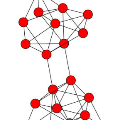In applications such as elderly care, dementia anti-wandering and pandemic control, it is important to ensure that people are within a predefined area for their safety and well-being. We propose GEM, a practical, semi-supervised geofencing system with network embedding, which is based only on ambient radio frequency (RF) signals. GEM models measured RF signal records as a weighted bipartite graph. With APs on one side and signal records on the other, it is able to precisely capture the relationships between signal records. GEM then learns node embeddings from the graph via a novel bipartite network embedding algorithm called BiSAGE, based on a graph neural network with a novel bi-level aggregation mechanism and non-uniform neighborhood sampling. Using the learned embeddings, GEM finally builds a one-class classification model via an enhanced histogram-based algorithm for in-out detection, i.e., to detect whether the user is inside the area or not. This model also keeps on improving with newly collected signal records. We demonstrate through extensive experiments in diverse environments that GEM shows state-of-the-art performance with up to 34% improvement in F-score. BiSAGE in GEM leads to a 54% improvement in F-score, as compared to the one without BiSAGE.
翻译:在老年人护理、痴呆症抗变性和大流行病控制等应用中,必须确保人们的安全和福祉处于预先确定的区域内。我们提议GEM,这是一个实用的、半监督的、带有网络嵌入的、仅以环境无线电频率(RF)信号为基础的半监视的地理栅系统。GEM模型测量了RF信号记录,将其作为一个加权双向双向图形。一方面是APs,另一方面是信号记录,它能够准确地捕捉信号记录之间的关系。GEM随后通过一个名为BisAGE的新型双边网络嵌入算法,从图表中学习节点嵌入。我们建议GEM, 以具有新型双级聚合机制和非统一社区取样功能的图形神经网络为基础。GEM最终通过一个强化的基于直观的内向检测算法, 即, 用来检测用户是否在区域内或外的信号记录。这个模型还继续随着新收集的信号记录而不断改进。我们通过在各种环境中进行广泛的实验,通过一个带有新型双级聚合机制的直径将GEM的GEM-M-34级的状态的改进,将GEM-FEM-iAG-AD-G-G-C-G-C-D-D-C-C-C-D-C-C-C-S-S-Airent-S-S-S-S-S-S-S-S-S-S-Air-S-S-S-S-Air-AG-A-Air-Air-Air-Air-S-S-S-S-AG-AG-AG-Air-Air-F-F-F-AG-Air-Air-Air-F-Air-Air-F-F-F-G-F-Air-F-A-Air-F-F-F-F-Air-F-F-F-F-F-F-F-F-G-F-Air-Air-F-F-F-F-F-Air-Air-Air-F-F-G-G-G-F-G-F-G-G-G-A-A-F-A-A-A-A-A-A-A-A-A-A



